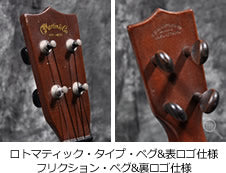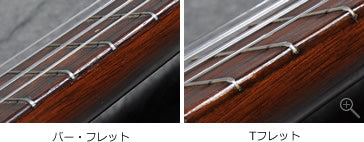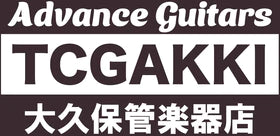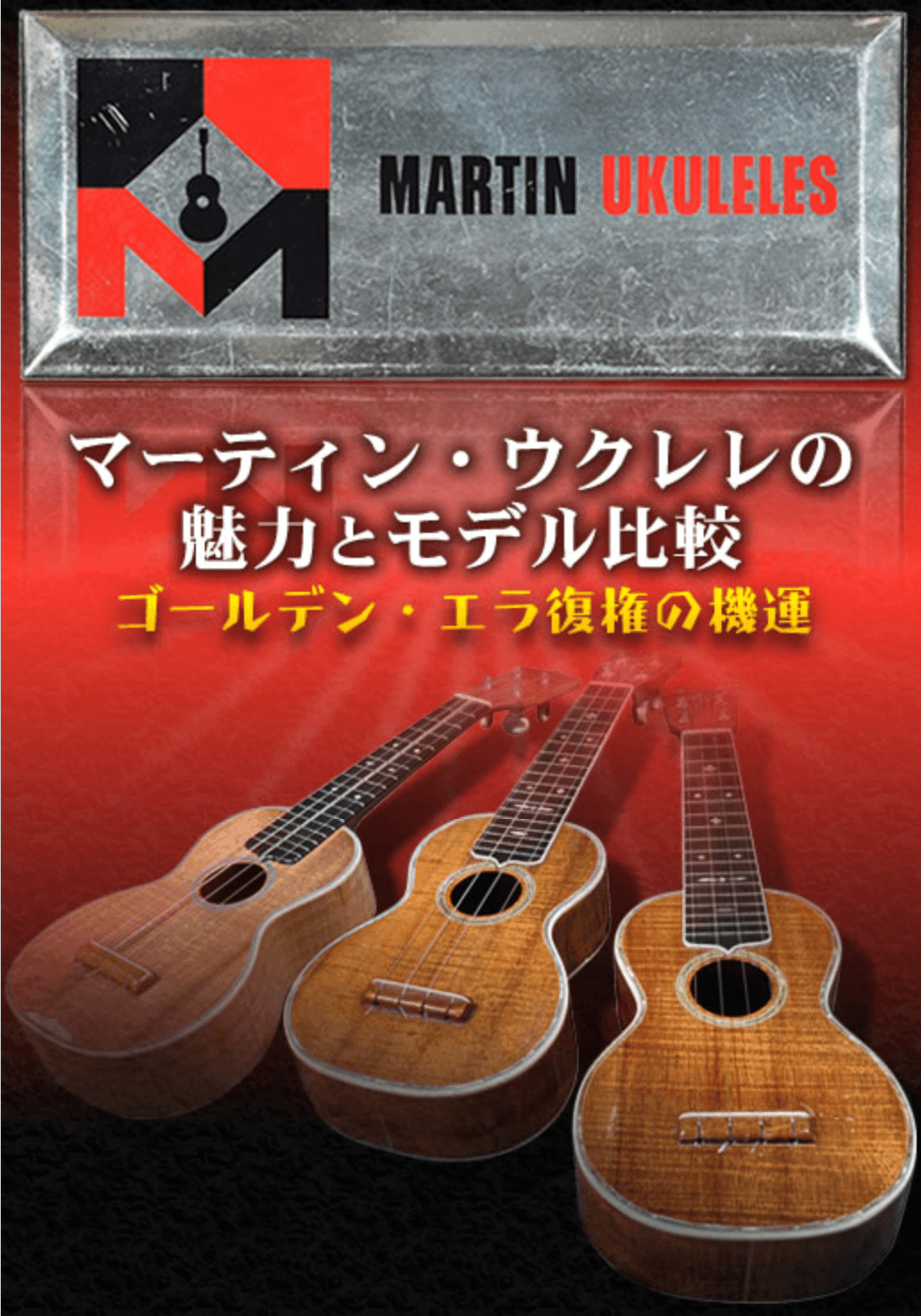



Fender" and "Gibson" in the electric guitar scene and "Martin" and "Gibson" in the acoustic guitar scene are generally recognized as the two giants in every genre. How about the ukulele? For those who know the ukulele well, "Martin" and "Kamaka" seem to be the standard ukulele playing style, but what is the perception of the younger generation of ukulele enthusiasts? Despite the fact that "ukulele god" Herb Ota used to play a Martin Style-3 in the '20s, there are not many Martin players in the world. Perhaps it's the strong impression of Martin as an acoustic guitar brand, or perhaps it's its expensive image, but the recognition of the Martin ukulele today seems to be somewhat low." Now that the ukulele boom is back with a vengeance and the ukulele genius Jake Shimabukuro, the "Jimi Hendrix of Hawaii," is drawing attention, we would like to unravel the twists and turns of the Martin ukulele's history and at the same time confirm its true value.
The Martin Guitar Company was founded in 1933 by C.F. Martin (Christian Frederick Martin Sr.), who came to the United States from Germany. Martin Sr. started out with a small workshop in the suburbs of New York, and produced a succession of guitars that incorporated innovative ideas from the free country of America, such as the "X-bracing" internal construction that has been handed down to the present day. The fruits of his labor blossomed in 1888, when his successor, the third generation F.H. Martin (Frank Henry Martin), showed great vitality and managerial ability. The Martin Guitar Company made a great leap forward, aided by the huge success of mandolins, which were in demand from the growing number of Italian immigrants in the U.S. at the time. It was also during this period that the company began producing ukuleles.
Around 1920, at the beginning of the 20th century, an unprecedented ukulele boom was taking place in the United States. It is recorded that the first Martin ukulele (prototype) was produced on December 10, 1907, at the request of Oliver Ditson, a Boston-based publishing company. However, the initial prototype was not well received. The spruce top and strong bracing gave it a heavy, guitar-like appearance that did not fit the image of the light, bouncy tone of the ukulele. After repeated trial and error, the prototype of the current Martin ukulele was completed. In 1916, the prototype was introduced to the market with a mahogany top instead of spruce, fewer braces, and a much thinner body material than that of a guitar. In 1920, the company began to produce ukuleles made of Hawaiian koa, and the bright and light sound reminiscent of Hawaiian ukuleles was accepted by more and more players.
In 1926, Martin produced 14,000 ukuleles, the largest number ever produced, but the popularity of the ukulele declined due to the economic instability caused by the waning of the boom and the end of World War II. In 1942, the Hawaiian koa version was discontinued, and the mahogany version, which had been actively produced until the mid-1960s, was discontinued in 1978 due to a sharp decline in demand. C.F. Martin III (Christian Frederick Martin III), son of Henry Martin, became his successor, and while the popularity of Martin acoustic guitars increased with the postwar folk music boom, the Martin ukulele continued on its path of decline. The Martin ukulele was on its way to decline.

In the 1990s, the company began producing the Style-0, Style-3, Style-1C, and Style-1T in the form of custom orders, but did not really start up again until the 2000s. The ukulele boom began again with the arrival of ukulele prodigy Jake Shimabukuro, the "Jimi Hendrix of Hawaii. His appearance attracted attention to high-quality ukuleles suitable for advanced playing, setting the stage for a re-evaluation of the Martin ukulele. In 2006, the legendary Style-5K was reissued by Chris Martin, the current CEO of Martin. The Style-5K was a perfect instrument that showed off the power of the Martin ukulele and its overwhelming presence. Since then, the Style-3, Style-2, and Hawaiian koa concert models have also been reissued, and the movement to restore the Golden Era of the ukulele is underway.
Differences between soprano models

Martin ukulele soprano models are classified into five styles: Style-0, Style-1, Style-2, Style-3, and Style-5. The basic specs of the Style-0-2 mahogany models are: top / mahogany veneer, S&B / mahogany veneer, neck / mahogany, fingerboard / rosewood, number of frets / 12 frets, rosette / 12 frets, and fingerboard / rosewood. Style-1K, 2K, 3K, and 5K have all Hawaiian koa veneer body, while Style-3 and 5 have ebony fingerboards.

The major difference between Style-0 and 2 is the body binding: Style-0 has no binding, Style-1 has rosewood binding (changed to dark plastic after 1938), and Style-2 has ivory binding on both top and back. Style-2 has Ivory binding on both top and back.

The Style-3, released in 1918, features a 5-ply rosette, 7-ply top binding, 3-ply back binding, fingerboard centerline, diamond pair inlays (changed to dots in the '40s and later), celluloid ornaments on the bottom of the top (gone in the ' 40s), and a 3-ply back binding. 40s), 17 frets. The high-end Style-5K model, introduced in 1922, has beautiful glossy Avalon inlays on the headstock (flower pots), body binding, rosette, and fingerboard (snow flake). The most attractive feature of this model is its luxurious and gorgeous look combined with the beautiful grain of the highest quality Hawaiian koa.
Changes in Specifications

There are a few specification changes that are useful for rough estimation of the year. First, the head logo: from 1916 to '33, "C.F. Martin & Co. After '33, decal (sticker) on the surface of the head. In some cases, there were both engraving and decal. Made in USA" was added to the "C.F. Martin & Co., Nazareth, PA" engraving inside the body after 1962.

As for frets, bar frets were used until 1934, and T frets were used after that. Finally, the pegs were changed from the basic wooden friction pegs to rotomatic type in 1927 for Style-0 and 1, and in 1923 for Style-2 and 3.

Martin Style-5K
The Style-5K is a rare instrument with gorgeous Avalon inlays, and deserves to be called the pinnacle of the ukulele scene. This is a gem that deserves to be called the pinnacle of the ukulele scene.

-
Body: Hawaiian Koa Wood
(Top & Back / Ivoroid & Avalon Binding) - Neck/Mahogany
-
Fingerboard/Ebony
(Snowflakes & Diamond & Cat's Eye Inlay, 17F, Ivoroid Binding) - Soundhole/Pearl Avalon & Black & White Wood
- Headstock/Hawaiian Koa Wood Top (Flower Pot Inlay), Mahogany Back
- Tuners/Ivoroid Patent

1922: Production started
1923:Start of listing in the catalog
1925:Avalon also inlaid on the side
1927: Avalon removed from sides
1940: Production discontinued
1941:Production of the Style-5 mahogany model begins
1942:Production of Style-5 mahogany model discontinued
Martin Style-3
Released in 1918 as a high-end lineup of Martin ukuleles, the Style-3 is a masterpiece that exudes character and presence with its three-line inlay on the fingerboard center, celluloid ornament on the top lower edge, and diamond pair inlay on the fingerboard. The three lines in the center of the fingerboard, celluloid ornamentation on the top lower edge, and diamond pair inlays on the fingerboard create a unique and distinctive piece.

- Body: Mahogany or Hawaiian Koa
- Neck: Mahogany or Hawaiian Koa
- Fingerboard/Ebony (Diamond Pair Inlay, 17F)
- Soundhole / White Celluloid & Ivory Maple (5 layers)
1918: Start of production (Early model only with 3-line inlay in the center of the fingerboard)
1920:Production of Style-3 Hawaiian Koa started
1923:Patent pegs are replaced and the ornament on the headstock is removed
1938: Production of Style-3 Hawaiian koa ends.
1977: Production ended
Martin Style-2
Ivory White binding on the top and back gives the Style-2 a unique character.

- Body: Mahogany or Hawaiian Koa
- Neck: Mahogany or Hawaiian Koa
- Fingerboard/Rosewood (small dot inlay, 12F)
- Binding/Ivory Celluloid
1916:Production started
1916-1922: Wooden friction pegs
1920:Production of Style-2 Hawaiian Koa begins
1923 onwards: Patent pegs
1933:Production of Style-2 Hawaiian Koa ends
1965:Production ended
Martin Style-1
Style-1 with rosewood binding (changed to dark plastic after 1938).

- Body: Mahogany or Hawaiian Koa
- Neck: Mahogany or Hawaiian Koa
- Fingerboard/Rosewood (small dot inlay, 12F)
- Binding/Rosewood
1916:Production started
1916-1926: Friction pegs
1920:Production of Style-1 Hawaiian Koa begins
1918-1937: Rosewood Binding
1927 onward: Patent pegs
1942:Production of Style-1 Hawaiian Koa discontinued
1965:Production ended
Martin Style-0
The Style-0, the eternal standard model of Martin ukulele, was produced for a long period of time from its release in 1916 to 1977.

- Body / Mahogany
- Neck / Mahogany
- Fingerboard/Hakaranda
- Bridge/Ebony
- Fretboard/12(12 fret joint)
1916: Production started
1916-1923:Mahogany nut
1924 onwards: Ebony nut
1922-1926: Wooden friction pegs
1927 and later: Patent pegs
1977:Final production
Others
In addition to soprano size, 1-C (Concert), 1-T (Tenor), Style-51 (Baritone), Taropatch (8 strings) and Tiple (10 strings) were also produced.

Tiple,Soprano,Concert,Tenor,Baritone (L.to.R)
★ 1-C (Concert)
Similar in decoration and finish to the Style-1, but one size larger than the Soprano. While the scale of the soprano is 346mm, the scale of the concert is 375mm.
- Body/Mahogany
- Neck/Mahogany
- Fingerboard/Rosewood (small dot inlay, 12F)
- Binding/Rosewood~Dark Plastic
- Patent Pegs
1925: Production started
1925-1937: Rosewood binding
1938:Dark plastic binding
1966:Discontinued
★ 1-T (Tenor)
Scale 432mm, suitable for solo player. Usually tuned to soprano with regular ukulele strings, but can also be tuned 5 degrees lower with gut strings.
- Body: Mahogany
- Neck / Mahogany
- Fingerboard/Rosewood (small dot inlay, 18F)
- Binding/Rosewood~Dark Plastic
- Patent Pegs
1928: Production started
1928-1937: Rosewood binding
1938:Dark plastic binding
1977:Discontinued
★ Style-51 (Baritone)
The Baritone is popular not only among solo players, but also recently among storytellers, and is often tuned to D-G-B-E, similar to the four strings on the treble side of the guitar.
- Body / Mahogany
- Neck / Mahogany
- Fingerboard/Rosewood (small dot inlay, 21F)
- Binding/Dark plastic
- Tuners/Patented pegs
1960: Production started
1977:Production ended

